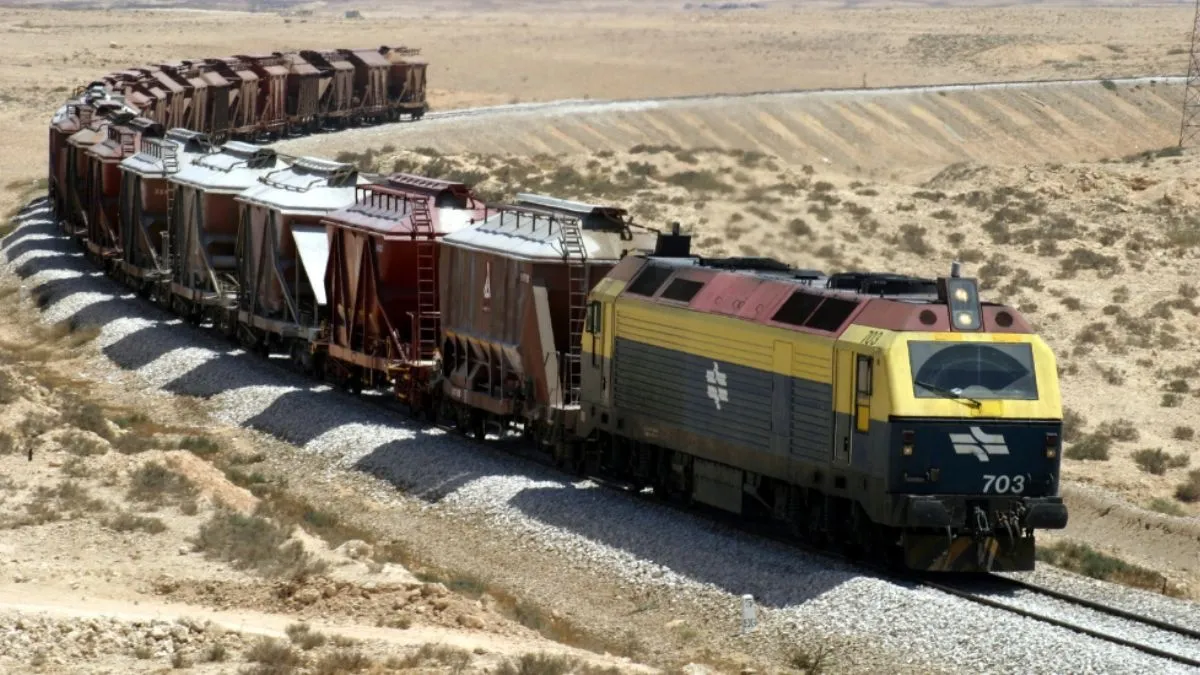During a discussion held yesterday by the National Planning and Building Council on the establishment of the 'Kadima' aggregates and cargo terminal, the committee approved the terminal plan and gave the Ministry of Transportation the 'green light' to continue and promote the plan.
Aggregates are the main raw material in malt and concrete, and serve as a vital component in all construction and paving works in Israel. Most of the aggregates are quarried in the Negev region and transported by trucks to demand areas, led by the Gush Dan metropolis.
The 'Kadima' terminal will be used for unloading aggregates that will arrive by train from the quarries in the Zafit and Tamar areas in the northeastern Negev, and will also include a cargo and container terminal. The terminal will be established east of the Kadima youth village located near Kiryat Malachi, on the existing Tel Aviv - Lod - Be'er Sheva railway line, and close to Highway 40 and Highway 6.
The approved terminal will join another cargo terminal that will serve the northern metropolis, previously approved by the National Council. The terminal is part of a system of national cargo movement terminals (MASHNAM), which were approved in a strategic plan for the deployment of national cargo movement terminals promoted by Israel Railways in the National Council, and which express the government's policy, which has determined the need for rail movement of sand and aggregates from the quarries in the southern region to the center of the country and thus will bring efficiency to the housing and paving industries.
According to forecasts, in the next decade there will be a need to transport about 16 million tons of raw materials per year from the south of the country to its center. The volume of transport requires rail movement, and without the development of the railway system, a severe shortage of raw materials will be created and it will not be possible to realize the construction volumes required in the central region of the country.
Moving such a quantity of aggregates by trucks means 400,000 trips of heavy trucks per year - and this is only in one direction, and it should be remembered that the trucks are supposed to return to the quarries. Truck traffic at these volumes on the southern roads will lead to a significant aggravation in terms of road safety, congestion on the roads, infrastructure wear and tear, and air and environmental pollution.
According to an updated forecast document published by the Ministry of Energy on the rail movement of aggregates and sand for the target year 2040, it presents a growth forecast from 10.6 million tons of aggregates today to 12 million tons, and growth from 6 million to 9 million tons of sand by 2040.
The plan underwent lengthy statutory processes in the national and regional planning institutions, and finally it was decided on the Kadima site as the most suitable and preferred location. Later, the paving of Highway 37 (formerly 39) is planned, which will connect the cargo terminal to Highway 6 and will expand the variety of movement options.
Transport Minister Miri Regev: 'I am a great believer in public transportation and especially the train, which carries thousands of passengers quickly and comfortably. A significant added value of the railway network is the ability to transport cargo in an efficient, safe and much more economical way than by trucks. Therefore, I have instructed to promote the development of the cargo railway network, which includes the establishment of advanced terminals across the country, and the council's decision today marks another step on the way to realizing the vision.'
CEO of the Ministry of Transportation and Road Safety, Moshe Ben Zaken: 'The Ministry of Transportation is promoting in March the development plans of Israel Railways, to the tune of 55 billion shekels. An important component of the plan is the expansion of the cargo transport network by train, and for this purpose we are promoting the direct connection of the seaports to the railway network, and the establishment of cargo terminals at strategic points across the country. The terminal network will soon be joined by the Kadima aggregates terminal, which is expected to contribute to the acceleration and reduction of the movement of aggregates to the construction and infrastructure industries.'
New Aggregates and Cargo Terminal to be Built in Kadima
The National Planning and Building Council has approved the 'Kadima' aggregates and cargo terminal, which will significantly improve the efficiency of transporting aggregates from the Negev to central Israel.
09:57 ,12.03.2025
-
Found it useful? Share
-
Share on Facebook
-
Share on X
-
Share on LinkedIn
-
Share via Email
-
Share on WhatsApp
-
Print Article
Related
 24.02.2025
24.02.2025
Israel Ports Company Signs Special Collective Agreement Benefiting Employees
 23.05.2016
23.05.2016
Israel to use new sea-borne missile defense to guard offshore gas platforms
 06.03.2016
06.03.2016
Israeli Government gave green light to negotiate conveying natural gas from Leviathan to Gaza Strip
 06.03.2016
06.03.2016
Israeli National Cyber Bureau: "Israel begun implementing national cyber strategy"
 24.09.2015
24.09.2015
Israel approves pipeline construction for exporting natural gas to Jordan
 04.01.2015
04.01.2015
Israel's population grew 2% in 2014 to 8.296 million

